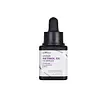What's inside
What's inside
 Key Ingredients
Key Ingredients

 Benefits
Benefits

 Concerns
Concerns

 Ingredients Side-by-side
Ingredients Side-by-side

Water
Skin ConditioningButylene Glycol
HumectantGlycerin
HumectantNiacinamide
SmoothingDibutyl Adipate
EmollientCaprylic/Capric Triglyceride
MaskingBakuchiol 0.6%
AntimicrobialAmmonium Acryloyldimethyltaurate/Vp Copolymer
1,2-Hexanediol
Skin ConditioningHydrogenated Lecithin
EmulsifyingBetaine
HumectantHydroxyacetophenone
AntioxidantRetinyl Palmitate 0.3%
Skin ConditioningSodium Stearoyl Glutamate
CleansingTocopherol
AntioxidantRetinol 0.1%
Skin ConditioningAllantoin
Skin ConditioningPanthenol
Skin ConditioningPolysorbate 20
EmulsifyingAdenosine
Skin ConditioningCetearyl Alcohol
EmollientDisodium EDTA
Stearic Acid
CleansingDipropylene Glycol
HumectantHydroxypropyl Cyclodextrin
MaskingPolydextrose
HumectantCeramide NP
Skin ConditioningAsiaticoside
AntioxidantMadecassic Acid
Skin ConditioningAsiatic Acid
Skin ConditioningCeramide Ns
Skin ConditioningCholesterol
EmollientPhytosphingosine
Skin ConditioningFerulic Acid
AntimicrobialCeramide As
Skin ConditioningCeramide AP
Skin ConditioningCopper Tripeptide-1
Skin ConditioningAcetyl Hexapeptide-8
HumectantPalmitoyl Pentapeptide-4
Skin ConditioningPalmitoyl Tetrapeptide-7
Skin ConditioningPalmitoyl Tripeptide-1
Skin ConditioningCeramide EOP
Skin ConditioningWater, Butylene Glycol, Glycerin, Niacinamide, Dibutyl Adipate, Caprylic/Capric Triglyceride, Bakuchiol 0.6%, Ammonium Acryloyldimethyltaurate/Vp Copolymer, 1,2-Hexanediol, Hydrogenated Lecithin, Betaine, Hydroxyacetophenone, Retinyl Palmitate 0.3%, Sodium Stearoyl Glutamate, Tocopherol, Retinol 0.1%, Allantoin, Panthenol, Polysorbate 20, Adenosine, Cetearyl Alcohol, Disodium EDTA, Stearic Acid, Dipropylene Glycol, Hydroxypropyl Cyclodextrin, Polydextrose, Ceramide NP, Asiaticoside, Madecassic Acid, Asiatic Acid, Ceramide Ns, Cholesterol, Phytosphingosine, Ferulic Acid, Ceramide As, Ceramide AP, Copper Tripeptide-1, Acetyl Hexapeptide-8, Palmitoyl Pentapeptide-4, Palmitoyl Tetrapeptide-7, Palmitoyl Tripeptide-1, Ceramide EOP
Water
Skin ConditioningPropylene Glycol
HumectantIsostearyl Isostearate
EmollientEthyl Olivate
EmollientDimethyl Isosorbide
SolventGlycerin
HumectantTriheptanoin
Skin ConditioningCetearyl Alcohol
EmollientSqualane
EmollientHydroxypinacolone Retinoate
Skin ConditioningBisabolol
MaskingSaccharide Isomerate
HumectantJojoba Esters
EmollientHelianthus Annuus Seed Oil
EmollientHelianthus Annuus Seed Wax
Skin ConditioningTocopherol
AntioxidantO-Cymen-5-Ol
AntimicrobialXanthan Gum
EmulsifyingGlyceryl Stearate
EmollientSodium Stearoyl Glutamate
CleansingCaprylyl Glycol
EmollientPolyglycerin-3
HumectantEthylhexylglycerin
Skin ConditioningSodium Citrate
BufferingCitric Acid
BufferingWater, Propylene Glycol, Isostearyl Isostearate, Ethyl Olivate, Dimethyl Isosorbide, Glycerin, Triheptanoin, Cetearyl Alcohol, Squalane, Hydroxypinacolone Retinoate, Bisabolol, Saccharide Isomerate, Jojoba Esters, Helianthus Annuus Seed Oil, Helianthus Annuus Seed Wax, Tocopherol, O-Cymen-5-Ol, Xanthan Gum, Glyceryl Stearate, Sodium Stearoyl Glutamate, Caprylyl Glycol, Polyglycerin-3, Ethylhexylglycerin, Sodium Citrate, Citric Acid
 Reviews
Reviews

Ingredients Explained
These ingredients are found in both products.
Ingredients higher up in an ingredient list are typically present in a larger amount.
Cetearyl alcohol is a mixture of two fatty alcohols: cetyl alcohol and stearyl alcohol. It is mainly used as an emulsifier. Emulsifiers help prevent the separation of oils and products. Due to its composition, it can also be used to thicken a product or help create foam.
Cetearyl alcohol is an emollient. Emollients help soothe and hydrate the skin by trapping moisture.
Studies show Cetearyl alcohol is non-toxic and non-irritating. The FDA allows products labeled "alcohol-free" to have fatty alcohols.
This ingredient is usually derived from plant oils such as palm, vegetable, or coconut oils. There is debate on whether this ingredient will cause acne.
Due to the fatty acid base, this ingredient may not be Malassezia folliculitis safe.
Learn more about Cetearyl AlcoholGlycerin is already naturally found in your skin. It helps moisturize and protect your skin.
A study from 2016 found glycerin to be more effective as a humectant than AHAs and hyaluronic acid.
As a humectant, it helps the skin stay hydrated by pulling moisture to your skin. The low molecular weight of glycerin allows it to pull moisture into the deeper layers of your skin.
Hydrated skin improves your skin barrier; Your skin barrier helps protect against irritants and bacteria.
Glycerin has also been found to have antimicrobial and antiviral properties. Due to these properties, glycerin is often used in wound and burn treatments.
In cosmetics, glycerin is usually derived from plants such as soybean or palm. However, it can also be sourced from animals, such as tallow or animal fat.
This ingredient is organic, colorless, odorless, and non-toxic.
Glycerin is the name for this ingredient in American English. British English uses Glycerol/Glycerine.
Learn more about GlycerinSodium Stearoyl Glutamate is an emulsifier and helps condition the skin. It is amino acid-based.
In higher amounts, it may act as a cleansing agent.
Tocopherol (also known as Vitamin E) is a common antioxidant used to help protect the skin from free-radicals and strengthen the skin barrier. It's also fat soluble - this means our skin is great at absorbing it.
Vitamin E also helps keep your natural skin lipids healthy. Your lipid skin barrier naturally consists of lipids, ceramides, and fatty acids. Vitamin E offers extra protection for your skin’s lipid barrier, keeping your skin healthy and nourished.
Another benefit is a bit of UV protection. Vitamin E helps reduce the damage caused by UVB rays. (It should not replace your sunscreen). Combining it with Vitamin C can decrease sunburned cells and hyperpigmentation after UV exposure.
You might have noticed Vitamin E + C often paired together. This is because it is great at stabilizing Vitamin C. Using the two together helps increase the effectiveness of both ingredients.
There are often claims that Vitamin E can reduce/prevent scarring, but these claims haven't been confirmed by scientific research.
Learn more about TocopherolWater. It's the most common cosmetic ingredient of all. You'll usually see it at the top of ingredient lists, meaning that it makes up the largest part of the product.
So why is it so popular? Water most often acts as a solvent - this means that it helps dissolve other ingredients into the formulation.
You'll also recognize water as that liquid we all need to stay alive. If you see this, drink a glass of water. Stay hydrated!
Learn more about Water